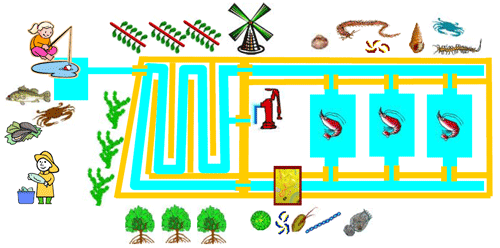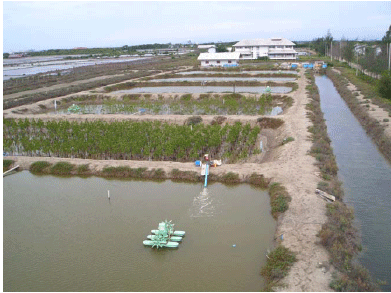Recycling-oriented aquaculture system utilizing natural ecological functions
Description
Coastal aquaculture in mangrove swamp areas has rapidly developed and expanded since the middle of the 1980s, and the production of cultured prawns has greatly increased. During the 25 years from 1975 to 2000, shrimp farming areas increased more than sixfold, from 129 km2 to 811 km2. However, excessively intensive utilization of brackish water areas has resulted in the destruction of many mangrove ecosystems and water pollution affecting the culture ponds and adjacent coastal areas. Recovery of mangrove ecosystems is of utmost importance for restoring the productivity of coastal aquaculture and fisheries. To develop a rational and sustainable utilization strategy for mangrove ecosystems, it is necessary to carry out studies relating to the practical use of coastal aquaculture systems that are compatible with the preservation of the environment.
To investigate rational and sustainable utilization of benthic organisms for prawn aquaculture, the community structure of macrobenthic organisms was examined in Samut Songkhram aquaculture ponds in the innermost part of the Gulf of Thailand. A total of 84 species/taxa of macrobenthos were identified, in which 42 species/taxa were found in the six experimental ponds: four ponds used for prawn culture and two ponds planted with mangrove stands. The dominant species belong to three taxonomic categories; that is, (1) sedentary, tube-dwelling spionids, Polydora sp., free-living nereids, Perinereis sp. and some other polychaetes (Annelida); (2) gastropods such as Cerithidea cingulata, Cerithium coralium, Thiara riqueti, and Stenothyra ovalis, which live on the surface or in the shallow layers of the substratum (Mollusca); and (3) barnacles, Balanus sp., and some small crustaceans such as ostracods, copepods, harpacticoids, amphipods and dipterans (Arthropoda). Population density, biomass and species diversity in the mangrove planted ponds were higher than those in the prawn culture ponds, and depending on their behavioral traits, the depth of sediment utilized.
Model experiments of a recycling-oriented prawn aquaculture that exploited the natural purification capacity of the mangrove ecosystem and the productivity of the macrobenthic community were carried out in the experimental ponds in Samut Songkhram. The survival rate and average weight of prawns in the water-circulated culture systems were higher than those in the closed culture system. When prawns were cultured under semi-intensive conditions in mangrove planted ponds, their average size increased about by 25%, and artificial feed could be reduced about by 19% compared to the intensive culture system. Diversity and biomass of the macrobenthos decreased during the culture experiments in the prawn culture ponds, while they increased in the mangrove ponds, indicating the possibility that the prawns fed on the small macrobenthos such as polychaetes and juvenile gastropods as a natural food source under aquaculture conditions. The results of feed preference experiments in the laboratory demonstrated that prawns significantly selected polychaetes and crustaceans over commercially sold pellet feed. It was concluded that macrobenthic invertebrates are an important natural feed for prawn aquaculture and may participate closely in the transfer of energy from the producer organisms to the cultured prawns.
On the basis of the results of the present study, we constructed a model of a recycling-oriented aquaculture system by utilizing the natural ecological functions of benthic and planktonic organisms, mangrove stands and seaweeds.
Figure, table
-
A model of recycling-oriented aquaculture system utilizing natural ecological functions of benthic and planktonic organisms, mangrove stands and seaweeds. -
Overview of recycling-oriented aquaculture system of Samut Songkhram.
- Affiliation
-
Japan International Research Center for Agricultural Sciences Fisheries Division
- Classification
-
Technical A
- Term of research
-
FY2005(FY2003~2005)
- Responsible researcher
-
FUJIOKA Yoshimi ( Fisheries Division )
SHIMODA Toru ( Fisheries Research Agency )
SRITHONG Chumpol ( Kasetsart University )
- ほか
- Publication, etc.
-
Fujioka Y. (2005) Sustainable production systems of aquatic animals in brackish mangrove areas. Report of the regional technical consultation for the development of code of practice for responsible aquaculture in mangrove ecosystems (ASEAN-SEAFDEC).
- Japanese PDF


